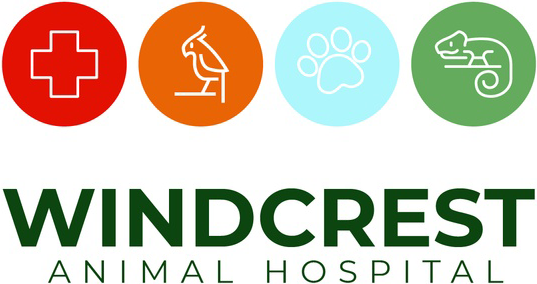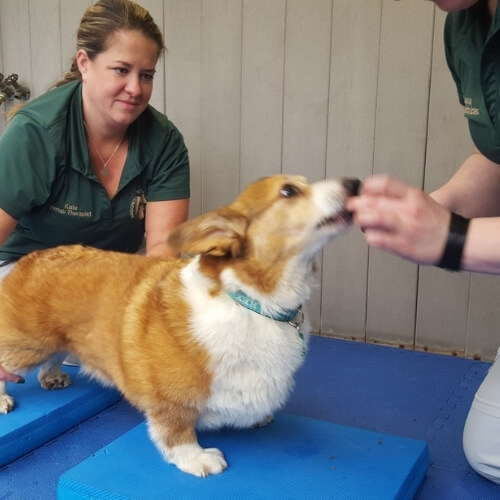ensuring a safe recovery
Rehabilitation
Animals, just like humans, need rehabilitative services for a variety of reasons.
Schedule Appointment
Access Portal

Pet Rehabilitation
Windcrest Animal Hospital offers the premiere pet rehabilitation services in Wilmington, DE, with highly trained and experienced specialists on staff. Whether suffering from arthritis, decreased mobility, or recovering from an injury or surgery, our specialists work closely with your veterinarian to design a personalized treatment program to optimize your pet’s path to recovery.
We welcome your call or email with any questions or to set up a consultation.
Our Veterinary Rehabilitation Referral Process
All rehabilitation patients must be referred by a veterinarian who approves of the care plan, maintains responsibility for the patient’s care throughout the process, and assumes ongoing responsibility for the patient’s care upon completion.
We will provide the referring veterinarian with a copy of the initial evaluation and all necessary documentation to communicate your pet’s needs.
Our Veterinary Rehabilitation Team
The team of dedicated rehabilitation professionals at Windcrest works as a referral service to the veterinary community.
Kate Christian, DPT, CCRP: Director of Rehabilitation Services
Dr. Kate received her Doctorate in Physical Therapy from the University of Delaware in 2005, where she also received her BA in Neuroscience in 2001. In 2007, she received her certification in canine rehabilitation from the University of Tennessee, College of Veterinary Medicine. Dr. Kate has worked at Windcrest Animal Hospital as a rehab specialist since 2005. A notable achievement is her status as the first therapist in Delaware to receive the title of Certified Canine Rehabilitation Practitioner. Dr. Kate’s dedication to her patients is evident as she closely monitors their progress and modifies the pet’s individual rehab plans accordingly. Her dedication to the field is also evident, as she hosts interns from both the University of Tennessee’s and the Canine Rehabilitation Institute’s certification programs. Dr. Kate continues to work with human patients as well as our four-legged friends. She is currently a physical therapist for children with special needs in schools in New Castle County. She has also worked with the elderly, providing rehab at long-term care facilities.
Advantages of
Pet Rehabilitation
- Provides maximized recovery from surgery
- Facilitates faster wound healing with our laser therapy
- Reduces pain and inflammation
- Provides accelerated healing of injured tissue
- Reduces need for anti-inflammatory drug usage
- Maintains and restores range of motion and muscle mass
- Builds strength and endurance
- Reduces gait abnormalities
- Improves overall function and quality of life
Pet Rehabilitation Treatments
Hydrotherapy
Our underwater treadmill allows animals to exercise without stressing their joints. Like a human treadmill, the speed can be increased and decreased, and the incline level can also be adjusted according to your pet’s needs. We also offer rehabilitative swimming, a beneficial cardiovascular exercise that offers a no-impact way to increase strength and endurance. All breeds of dogs can benefit from swimming, and most love it! Our hydrotherapy is not limited to just dogs; other pets, including cats and even a rabbit, have reaped the benefits of this therapy.
Therapeutic Laser
Deep-penetrating photons from the laser affect the chemistry of a cell in a variety of helpful ways. Pets receiving laser therapy after surgery have less pain and fewer complications, and they typically recover faster. Laser therapy can reduce your pet’s healing time for wounds and speed up regeneration. It also helps decrease inflammation and pain resulting from chronic conditions such as arthritis or chronic tendon/muscle strains.
Electrical Stimulation
Electric stimulation helps relieve pain, prevent muscle atrophy, and increase the strength of underutilized muscles. An electrical current is delivered through electrodes placed on the skin over a muscle or a muscle group. Electric stimulation is ideal for post-surgical patients who are non-weight bearing or have restricted use of specific muscles.
Pet Therapeutic Ultrasound
Therapeutic ultrasound is a heating agent for deep tissue. We use it to aid in the recovery of musculoskeletal injuries. It increases blood flow to the affected area and accelerates your pet’s healing process. Ultrasound is very effective in treating joint motion limiting conditions and soft tissue injuries.
Manual Therapy
Our therapists use their hands in every treatment, whether for a relaxing massage to help warm up the muscles for a workout or intense joint mobilizations. Deep tissue massage, stretching, and cross friction massage are other forms of manual therapy used to help pets in their recovery.
Therapeutic Exercise for Pets
Therapeutic exercise offers an array of benefits for pets in rehabilitation:
- Increases weight bearing
- Helps correct gait abnormalities
- Strengthens
- Improves proprioception
- Improves balance
- Improves quality of movement
For more information on pet physical rehabilitation, click here to read an article written by Kate Christian on the benefits and modalities of pet rehab.
Pet Rehabilitation FAQs
Why canine rehabilitation?
- The benefits of human physical therapy have been proven for many years. We have adopted the principles of human physical therapy to meet the needs of your pet.
- The goals of physical rehabilitation are to maximize your pet’s recovery and increase function and improve the overall quality of life.
How long after surgery should my pet begin rehab?
Depending on the surgery and your veterinarian’s recommendations, your pet could begin rehab right away. The immediate treatment plan will mostly consist of passive exercises, management of pain and inflammation, which you can start at home or in the rehab clinic. After the surgical incision is healed and/or your pet is cleared by the surgeon, they can begin more intensive rehab, including hydrotherapy and therapeutic exercises. Typically, rehab in the clinic is started by 2 weeks post-op.
Can I watch my pet’s rehab?
We encourage owners to watch and even participate in the rehab sessions with their pets. We know that some animals are scared or nervous without their owners with them, and we want your pet to be as comfortable as possible for their rehabilitation. You will also learn how to perform home exercises and how and when to advance these exercises.
How long do the treatments last?
The initial consultation is one hour, and each subsequent treatment is either 30 or 45 minutes, depending upon your pet’s needs.
My dog does not like water. Can he still participate in therapy?
- Many patients will get their exercise using the underwater treadmill as it provides a controlled exercise environment, although the pool offers many other benefits.
- However, if your pet does not tolerate the water, there are plenty of other forms of exercise and therapeutic modalities to help your pet.
I have a senior pet. Can he still benefit from rehab?
There is no age limit for rehabilitation. Sometimes older pets can benefit the most from rehab. Since our rehab therapist individualizes each treatment, the program for your elderly pet will be tailored for their specific condition and function. For example, if necessary, your pet can take more breaks while in the pool or walk slower on the underwater treadmill.
What are some of the benefits?
- Promotion of tissue repair
- Decreased inflammation and muscle spasms
- Increased mobility, strength and endurance
- Cardiovascular benefits without stress on joints
- Reduced pain and discomfort
Is rehab only for pets that have had surgery?
Rehabilitation is for any pet with any of the symptoms or diagnoses mentioned previously. Arthritis is one of the foremost indications for rehab.
Do I have to be present for the rehab session?
No. You can wait in the lobby, or you can drop off for the treatment. We have a full kennel that your dog can stay in if you’re dropping off and/or picking up outside the rehab appointment. There is no extra charge for kenneling your dog on the day of their rehab treatment.
Can I do anything to help at home?
Each consultation is an individualized home exercise program for the owner to perform with their pet at home. This is one of the most important parts of the rehab process. This may change every few visits, so we re-educate the owners with each update.
How often and how long will my pet need to come to therapy?
This depends upon the condition and individual progress of the animal as well as the diagnosis and prognosis. In general, a typical orthopedic patient will be in therapy once or twice a week for four to eight weeks. Many clients choose to continue rehab for longer periods of time for maintenance, especially for those pets with degenerative or progressive conditions, such as arthritis or neuropathy.
What is the temperature in the pool and underwater treadmill?
The temperature is kept between 82 and 87 degrees. The warm water increases circulation to the muscles and joints, increases joint flexibility, and decreases joint pain.
For more information about our rehabilitation services or to schedule an appointment to discuss your pet’s rehabilitation, wellness, or sick care needs, contact us today.



